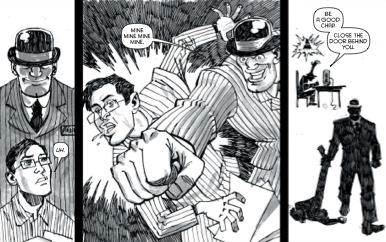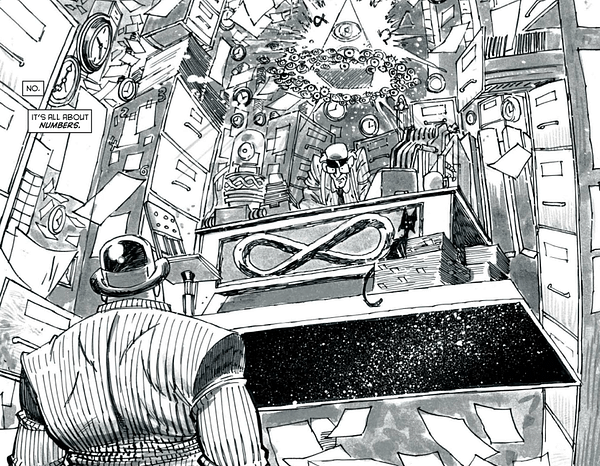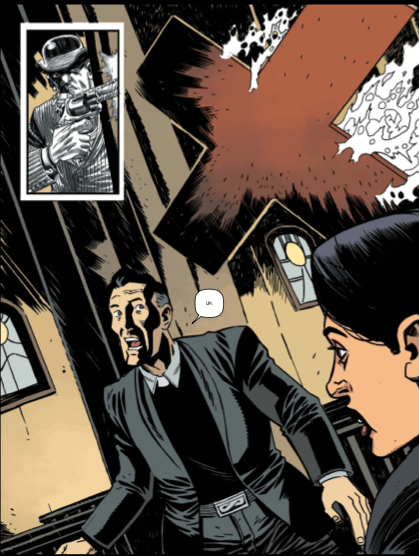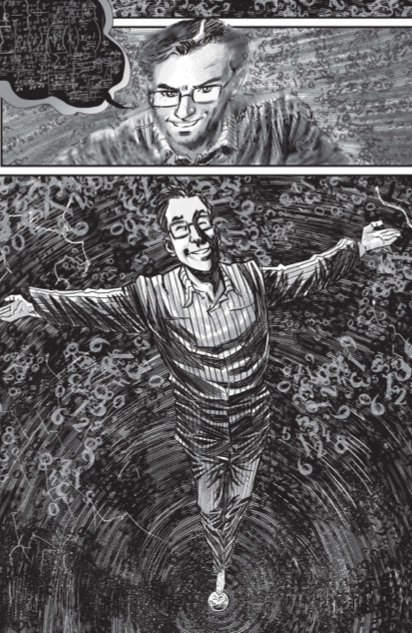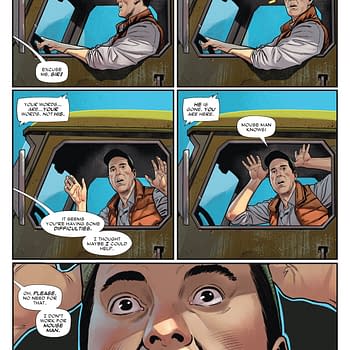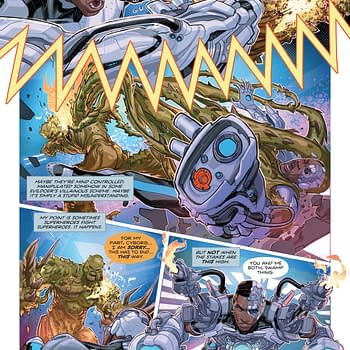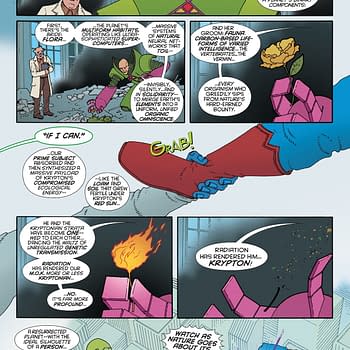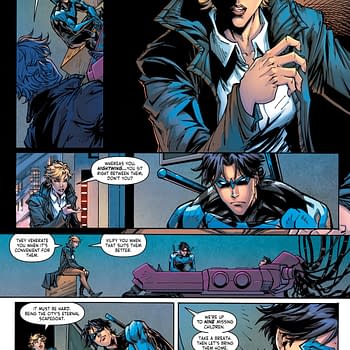Posted in: Comics, Recent Updates | Tagged: Comics, entertainment, Jordie Bellaire, judge dredd megazine, numbercruncher, pj holden, Simon Bowland, simon spurrier, Titan Entertainment
Why You Shouldn't Just Read Numbercruncher, You Should Read It All At Once
Numbercruncher is a fabulously strange comic. It first appeared serialized in the pages of Judge Dredd Megazine in black and white, then as a 4 issue miniseries with colors added, and has now been collected in hardback by Titan. Written by Simon Spurrier, with artwork by PJ Holden, colors by Jordie Bellaire, and letters by Simon Bowland, the first thing you'll notice about the comic is how compressed it is, something that's becoming unusual these days. At a guess, it's likely that this kind of densely crafted storytelling relates to its short-form serial origin in Judge Dredd Megazine, but the fact that the story builds upon that tension and density to create a stunning whole, where 4 issues collected feels like a much, much longer work is remarkable. For that reason, the unique combination of density and its ability to stretch into a longer form work, it really is best to read Numbercruncher all at once. Or at least in a single day.
That may seem heretical, since a major selling point of the comics format is that the reader controls the pace and can make those decisions with luxuriously arbitrary abandon. You theoretically could read one panel of a comic a day and that would be your chosen reading experience (just as many webcomics do post a single panel a day or week). But I've heard several readers confirm my initial impression and offer this advice: Numbercruncher in collected edition is a particularly powerful experience because you can read it all at once.
What are the features that particularly make a single sitting useful? To start with, it has a unified concept that plays on repetition with variation. It's difficult to sum up the premise of the comic, and in the collected edition, an interview with Simon Spurrier reveals that he had a unique "all at once" experience when he thought of the concept. He says he can remember "exactly" where he was when it "hit him", cycling alone on a Mediterranean island, an "idea" and a "plot fully formed", which he considers highly unusual. The "barebones" of the story for Spurrier included a "guy dies young, but he's so totally in love that he decides to cheat the rules of reincarnation so he can return to his lover. The Universe tries to stop him…" Spurrier also points out that the plot "coils" around about 50 years of history and that coiling effect is exactly why reading it all at once is useful, we get the repetition of the coils of the story while the variation brings us closer to a culmination of the narrative.
Basically, we are witnessing the goings on of the universe at a metaphysical level, tracking the behavior of souls after death, and all of this is framed by mathematical constructs but hammered home by a Brazil-like office-setting (referring to the Gilliam film) of the metaphysical agents keeping things moving like clockwork. The "Divine Calculator", a canny boss whose mind keeps a grip on the Alpha and Omega of things dispenses the tedious work to his operatives.
Only there's one soul—a brilliant mathematician who died young, and in love, who bucks the system when bucking doesn't seem like a viable option: Richard Thyme. He starts off small in his gamble, and bargains for one more reincarnation in exchange for a possible eternity in a drudgery-laden job for the heavenly home office. His goal is to find his lover again during her lifetime by retaining memories of his previous life. The rest is vast and ingenious, building complication. And that is the story of Numbercruncher, withholding the spoilers that make it intensely entertaining, and certainly very tense from panel to panel.
There's repetition with variation as our mathematician tries various methods to prolong his time on earth, to inch closer to his goal, and the learning process for him is excruciatingly slow but never tedious for the reader. Due to that compressed storytelling I mentioned earlier, not an inch of comics real-estate is wasted and there are so many details infused into each panel that you feel like you're being a slouch if you don't pore over each page. It's one of those comics you end up holding close to your face just to make sure you're not missing anything. Let's clearly credit the artwork of PJ Holden for that, whose cartoony intense facial expressions convey so much emotion and humor that the human characters are profoundly entertaining, and whose commitment to architecture and clothing creates a whole strange world you otherwise could not inwardly imagine it's so complex in its rules and ideas. I mean, seeing The Divine Calculator's desk hovering in an overcrowded, weightless office set in a starfield and graced with various esoteric symbols hovering over him pretty much sets the tone for the book: both reassuringly solid and disconcertingly unpredictable.
So, it's unified quality and repetition with variation mean that reading it all at once is a useful thing. That way, you can keep in mind and appreciate the variation in Thyme's attempts to create the outcome he wants from his prolonged and repeating incarnations. If you do not read the whole of the comic in a short space of time, you will still appreciate it—it's that kind of comic—however, the details are likely to be overlooked, mislaid in your mind, and you will fail to grasp its intricacy. If you feel yourself slipping and not noticing enough, a collected edition also means that details can be referred back to. This is particularly going to be the case when you finish reading the comic. I doubt there are many readers, who having completed their read, didn't turn back and look for key elements that suddenly appear in a new light. What's the fun of appreciating intricate storytelling if you don't at least once confirm that you should kick yourself for not noticing something? A collected edition helps you hurl insults at yourself in a well-deserved way but that's ok because you'll mainly be praising the comic.
But on a purely experiential level, a good reason to read the comic all at once is that it has a driving pace that just doesn't let up. The realization that this story could have been stretched much, much further in a bid to make sales and money should give you pause to congratulate the creative team behind it for not making that a motive in their work. They conceived of it as a tale best told in origami-like folded layers that would display to best affect when neatly overlaid. And so they did that. This is a story where more asides and incidents could have been folded in, in fact vast swathes of time are brushed over so that you can see the pattern of things more clearly and the big picture concepts involved. The creators chose compressed brevity over expansive, discursive narrative (which often has its place in storytelling of a different variety) and by doing that they really get the reader committed to the comic very quickly.
I dread to think how painful it would have been to read this comic in short installments, though that was originally part of the design of the work, and I can only imagine readers puzzling it out and laying copies of 2000AD alongside each other, essentially re-reading the installments as each one redefined the previous ones. So thank your lucky stars you now have the option of reading it all at once. The conflict between Richard Thyme and the powers that be as he attempts to eke more and more time on earth out of his fated lot escalates so fiercely and relentlessly that if you have the collected edition, well, I probably don't need to make this argument because you will read it all at once anyway.
Any doubts remaining? Well, you'll just have to try it for yourself and see if you are inclined to read it all at once or not. Feel free to let me know here at Bleeding Cool what your reactions are or have been. At any rate, Numbercruncher is one of the sleeping giants of recent comics and if you like clever stories that are fantastical and deal in high concepts while remaining earthy and humorous, and even managing to be disarmingly violent, then don't miss this book.
Here's the trailer for the collection:
[youtube]http://youtu.be/MiHEl7jYVkU[/youtube]
Hannah Means-Shannon is EIC at Bleeding Cool and @hannahmenzies on Twitter



